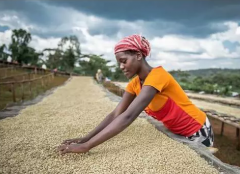Central Valley Sonora Coffee Plantation Why Sunlight and Honey
Sonora Manor is located in the central valley of Costa Rica at the foot of the world-famous Boas volcano. The estate covers an area of 100 hectares, of which 55 hectares are coffee growing areas, 35 hectares are virgin forest reserves, and the remaining 10 hectares are sugar cane growing areas with an average elevation of 1200 meters above sea level.
The estate's small coffee processing plant is built near a 150-year-old sugar processing plant near the heartland, which is well preserved and functioning. All the machines at the coffee processing station operate in the most efficient manner, using the energy recovery system within the manor.
The coffee treatment of Sonora Manor is basically only honey treatment and sun treatment. They have rich experience in all kinds of honey treatment and sun treatment, and these two methods require more manpower and energy than traditional washing treatment. But when you taste the results in the cup, such efforts are meaningful. By interestingly trying different processing techniques, we can taste coffee with clearer sweetness and tropical fruit flavor.
Another important advantage is that a lot of water can be saved through honey treatment and sun treatment. Honey-treated coffee can save nearly 12 litres of water per pound during coffee processing, while sun-treated coffee does not need any water.
The Costa Rican Villalobos variety was discovered by people at Torres Manor in the wild where they were planted. In fact, it is a dwarf variety of the Typica variety, dating back to the 1600s, brought to Indonesia by the Dutch and then spread around the world, and is now widely cultivated in Costa Rica. This variety of coffee has a strong floral aroma and soft sweet and sour, and it also has a special drupe flavor, such as apricot, peach, red berry, black brine.
In addition, this coffee is a relatively soft coffee bean.

Important Notice :
前街咖啡 FrontStreet Coffee has moved to new addredd:
FrontStreet Coffee Address: 315,Donghua East Road,GuangZhou
Tel:020 38364473
- Prev

Kaduai boutique coffee cup flavor test in Sonora Coffee Manor, Costa Rica
Costa Rica Sonora Manor Kaduai Origin: Costa Rica altitude: 1500-1700 m Cup score: 87 points treatment: sun baking degree: medium to shallow baking flavor taste: berry aroma, strawberry, red plum, lively and bright acidity, juice-like sweet and sour taste, moderate Body.
- Next

Ethiopia boutique coffee producing area WenagoG1 Yadamei of Ethiopia
In addition to the small town of Yega Xuefei, it also includes three by-product areas such as Wenago, Kochere and Gelena/Abaya around it. 1. Planting system and environment the mountain stream village in the Yega Xuefei producing area is cool and foggy, like spring all the year round, with a gentle breeze in summer, cool but not hot, rain but not damp, and no cold damage in winter, which is the best environment for planting Arabica. There are no large coffee plantations, coffee.
Related
- Detailed explanation of Jadeite planting Land in Panamanian Jadeite Manor introduction to the grading system of Jadeite competitive bidding, Red bid, Green bid and Rose Summer
- Story of Coffee planting in Brenka region of Costa Rica Stonehenge Manor anaerobic heavy honey treatment of flavor mouth
- What's on the barrel of Blue Mountain Coffee beans?
- Can American coffee also pull flowers? How to use hot American style to pull out a good-looking pattern?
- Can you make a cold extract with coffee beans? What is the right proportion for cold-extracted coffee formula?
- Indonesian PWN Gold Mandrine Coffee Origin Features Flavor How to Chong? Mandolin coffee is American.
- A brief introduction to the flavor characteristics of Brazilian yellow bourbon coffee beans
- What is the effect of different water quality on the flavor of cold-extracted coffee? What kind of water is best for brewing coffee?
- Why do you think of Rose Summer whenever you mention Panamanian coffee?
- Introduction to the characteristics of authentic blue mountain coffee bean producing areas? What is the CIB Coffee Authority in Jamaica?

